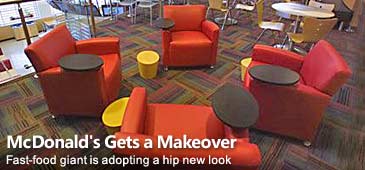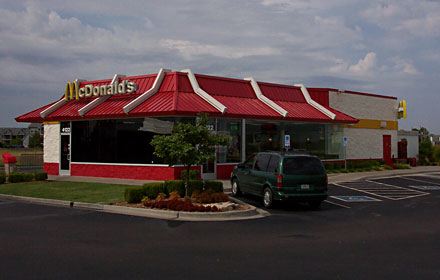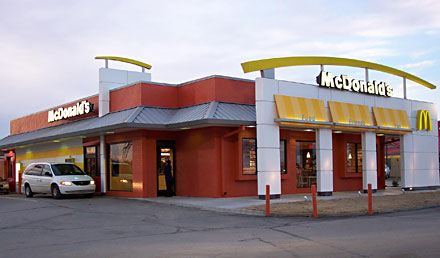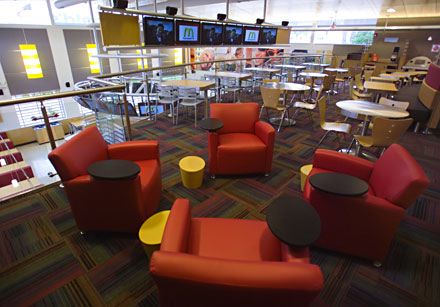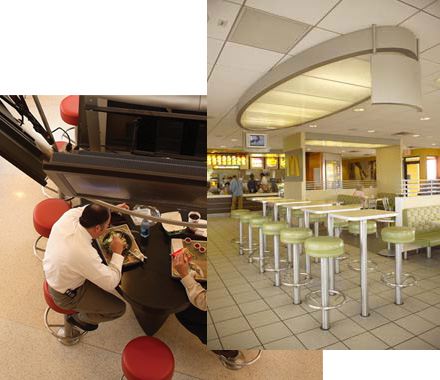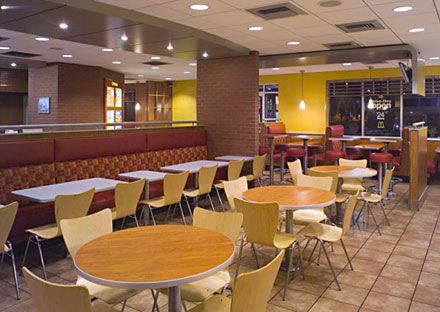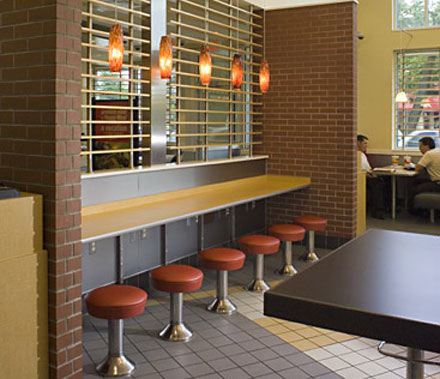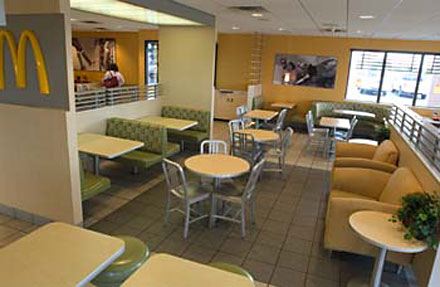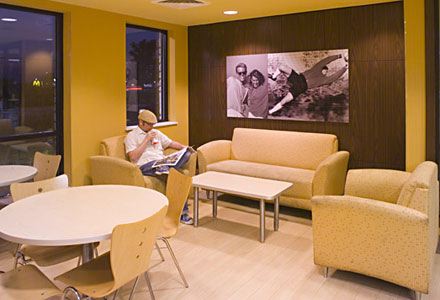A comfortable armchair.
Cool hanging lights. Funky graphics and photos on the walls. Wi-Fi
access. Premium coffee. Isn't Starbucks great? Except...this is
McDonald's.
McDonald's? That's right. After 30 years without a major design
overhaul, the 51-year-old fast-food giant is adopting a hip new look.
The world's largest hamburger chain is redesigning its 30,000 eateries
around the globe in a 21st century makeover of unprecedented scale.
The redesign is risky and has many franchisees up in arms over the high
costs of a makeover. But company officials believe the overhaul is
needed. McDonald's, whose restaurants are visited by more than 40
million people every day, has moved aggressively over the past three
years to revamp its menu and attract a new breed of customer. It has
added healthier items like premium salads targeted at women, and apple
slices and skim milk for children. But as more upscale items like Asian
chicken salad show up on its menu, the chain's typical starkly lit,
plastic-heavy look is at odds with the contemporary, welcoming image the
company wants to present.
"McDonald's promises to be a 'forever young' brand," says John Miologos,
vice-president of worldwide architecture, design, and construction at
McDonald's Corp. "We have to deliver on that promise." The last major
change at McDonald's restaurants was the introduction of play places for
children in the early 1980s.
'Think iPod'
What will the new McDonald's look like? "Think iPod: clean lines,
simplicity," says Miologos. The signature mansard roof? History. "The
big red roof looks too dated today," says John Bricker, creative
director at design firm Gensler's brand-strategy arm, Studio 585. It's
being replaced by a flat roof topped by a newly designed, contemporary,
golden sloping curve. Ronald McDonald appears safe: The mascot was given
a leaner, sportier look just last year. And the iconic twin golden
arches will still play a big role in the branding.
After conducting a global contest among design firms, the burger giant
chose New York-based Lippincott Mercer in the summer of 2004. Peter
Dixon, the design firm's creative director, spent 2005 with McDonald's
internal architecture and design team testing and prototyping the new
look, which is being officially rolled out this year. Lippincott Mercer,
which until it signed McDonald's had few clients in the restaurant
business, has made a name for itself working with companies going
through a shift in brand identity and image. In 2002, for example, it
helped redesign Nissan dealerships to reflect the company's launch of
several new upscale cars. Within a year, the redesigned dealerships saw
an average of 57% sales growth, vs. 33% overall.
The traditional McDonald's yellow and red colors will remain, but the
red will be muted to terra cotta and olive and sage green will be added
to the mix. To warm up their look, the restaurants will have less
plastic and more brick and wood, with modern hanging lights to produce a
softer glow. Contemporary art or framed photographs will hang on the
walls. Bob Dixon, a private school fund-raiser in Chicago, says of an
Oak Brook, Ill., restaurant that sports the new design: "It's bright,
it's lively, it's clean. It stunned me how beautiful it was."
The dining area will be separated into three sections with distinct
personalities. The "linger" zone will offer comfortable armchairs,
sofas, and Wi-Fi connections. "The focus is on young adults who want to
socialize, hang out, and linger," says Dixon. Brand consultant Robert
Passikoff, president of Brand Keys, a brand consulting firm, says that
Starbucks has raised the bar: "A level has been set by Starbucks, which
offers the experience of relaxed chairs and a clean environment where
people feel comfortable hanging out even if it's just over a cup of
coffee."
The "grab and go" zone will feature tall counters with bar stools for
customers who eat alone; plasma TVs will offer them news and weather
reports. And in the "flexible" zone, families will have booths featuring
fabric cushions with colorful patterns and flexible seating. The new
design allows different music to be targeted to each zone.
A 21st-century look is expensive
McDonald's won't confirm the cost of a redesign. Richard Adams, a former
franchisee and consultant to current owners, estimates they will have to
pay $300,000 to $400,000 to renovate an existing outlet -- an amount
roughly equal to a restaurant's annual profit. Tearing down a store and
rebuilding from scratch could cost $1 million, Adams says. The
franchisees will have to pay for the renovations themselves, which has
some of them seething. "Many franchisees are dead set against this
change, especially because they already spent millions remodeling their
restaurants in the past four years," says Adams. In 2002, when
McDonald's introduced premium salads, it did ask a number of franchisees
to spruce up their dining rooms, but it wasn't a major redesign project.
McDonald's says it worked collaboratively with franchisees to jointly
develop a strategy for the current "re-imaging" of its restaurants.
In a recent letter to management at the company's headquarters in Oak
Brook, about 160 franchisees from North Carolina spelled out why they
oppose the new plan. They say the roof change erases 40 years of brand
building and that "there has been no business case presented which
justifies the change." Says Frederick Huebner, who owns 11 McDonald's in
North Carolina: "We don't want to lose the iconic look of what we've
got." If franchisees balk, McDonald's can refuse to renew their
contract.
Right now, only 20 recently opened restaurants in the U.S. sport the
makeover in its entirety. Another 20, primarily in Tulsa, Okla., and
Columbus, Ohio, have been completely remodeled. All brand-new
restaurants will have to hew to the redesign blueprints, and by the end
of 2006, more than half of the 13,720 U.S. restaurants will feature some
element of the design. Says Gensler's Bricker: "It's something that
McDonald's has to do if it wants to be part of the 21st century."
|
